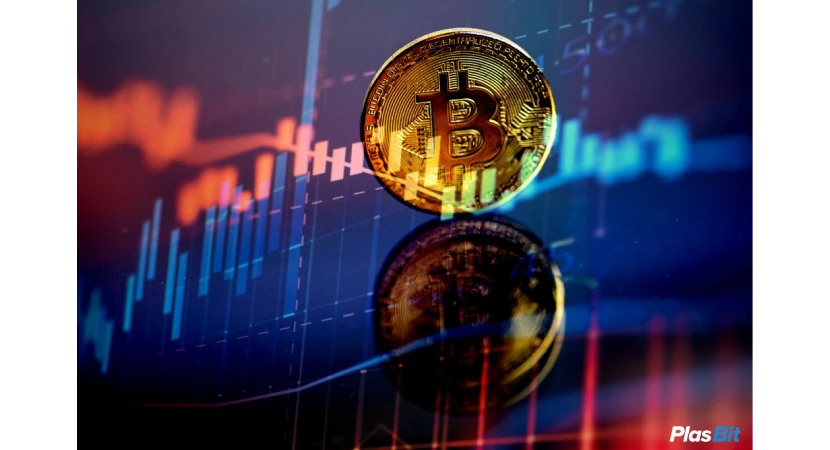Choosing whether to trade crypto actively or hold onto it for the long haul can feel like a high-stakes game of predicting the market's mood swings, nobody said it would be a cakewalk. In short, the answer to the question Is it better to trade or hold crypto? Holding crypto for the long term and disregarding economic news and price volatility in the short term has statistically proven to get higher returns than day or swing trading and trying to time the market. Trading on a highly volatile crypto market using technical analysis requires financial knowledge, nerves of steel and a significant portfolio size, otherwise, you will have to use leverage to gain significant profits and this can be very risky, which is why it is only recommended for experienced individuals.
Our thorough exploration of both tactics will illuminate which strategy might pave the way to your financial success.
What is Crypto Trading?
Crypto trading involves buying and selling cryptocurrencies on various exchanges to take advantage of price movements. It requires a deep understanding of technical analysis, market volatility, and risk management, making it suitable for advanced investors looking for short-term gains.
Crypto trading is like riding the waves of market prices. Traders buy and sell cryptocurrencies within a short time, hoping to make money on quick price changes. It's thrilling but not easy—it takes a lot of watching and knowing when to act fast.
With day trading, we're betting on those rapid swings to grab profits daily.
Who is the perfect “fit” for crypto trading?
Trading crypto is only for some. Advanced investors use charts, study market trends, and keep up with news that could change coin prices fast. They aren’t afraid to exchange crypto-to-crypto, which is tough for newbies.
They know the game well—like expert chess players planning many moves.
These traders might spend hours each day watching screens, ready to buy or sell immediately. They use tricky strategies like scalping or leverage to make more money, but these can be risky, too.
You need lots of knowledge about technical analysis and market cycles if you want to trade this way. And remember, it takes time and practice to get good at it!
Which are the most popular crypto trading coins?
In the dynamic world of cryptocurrency, several coins stand out for their popularity and trading volume. At the forefront is Bitcoin, the original cryptocurrency that continues to dominate the market as a benchmark for others. It's the go-to choice for many traders due to its established reputation and widespread acceptance. It’s also booming, as the news for Bitcoin ETF approval from the SEC (US Security Exchange Commission) is hot, and the Bitcoin halving due this year might completely change the whole industry. Many analysts predict $BTC to hit $100K this year, although we have to say the same one predicted such price increases for 2023,2022, etc. So take it with a pinch of salt.
Besides Bitcoin, the crypto market is brimming with promising altcoins, each offering unique features and potential for traders. Currently trending are Solana and Avalanche, known for their innovative blockchain technologies that promise improved scalability and speed. Ethereum, another stalwart in the crypto space, is gaining momentum, especially with its transition to Ethereum 2.0, which aims to enhance efficiency and reduce environmental impact.
Other popular trading coins include Binance Coin, with its strong association with the Binance exchange platform, and Cardano, which gets recognition for its scientific approach to blockchain development. Ripple (XRP) remains a choice for traders interested in fast, cross-border transactions. Polkadot and Chainlink are also gaining traction for their interoperability and real-world data integration.
Lastly, Litecoin and Dogecoin, though older, continue to be favored for their established communities and ongoing development. These coins, each with their distinct features, collectively represent the vibrant and diverse nature of the crypto trading landscape.
Pros and Cons of Crypto Trading
Is it better to trade or hold crypto? Well, the next section will answer half the question. Let’s see the pros and cons of crypto trading.
Pros
- High-Profit Potential: Crypto trading offers the potential for significant profits due to the high volatility of cryptocurrency markets. Traders can capitalize on rapid price movements to make gains, often within a short time frame.
- 24/7 Market Access: Unlike traditional stock markets, the cryptocurrency market operates 24/7. It provides traders with the flexibility to trade at any time, allowing them to respond quickly to market news and trends.
- Diverse Trading Options: Crypto trading platforms offer various trading options, including spot trading, futures, and margin trading. This diversity allows traders to employ different strategies and leverage their positions to maximize potential returns.
- Learning and Skill Development: Engaging in crypto trading can be a valuable educational experience. Traders learn to analyze market trends, understand blockchain technology, and develop risk management skills. This knowledge can be beneficial for broader financial and investment decisions.
Cons
- High Risk and Volatility: Cryptocurrency markets are known for their extreme volatility, making trading risky. Price swings can be sudden and dramatic, potentially leading to significant losses, especially for inexperienced traders.
- Time-Consuming: Successful crypto trading requires a significant time investment. Traders must constantly monitor the market, stay updated with crypto news, and analyze trends. The whole process can be overwhelming and is only suitable for some.
- Emotional Stress: The rapid and unpredictable nature of the crypto market can lead to emotional stress and anxiety. The pressure of making quick decisions, experiencing financial losses, and fearing missing out (FOMO) can be challenging for traders to manage effectively daily.
What is Cryptocurrency Holding (HODLing)?
Cryptocurrency holding, often called "HODLing," involves purchasing digital assets and holding onto them for an extended period. It's a long-term investment method that aims to capitalize on potential future value increases in the crypto market and often involves cold crypto wallets to protect the funds.
Holding offers benefits such as simplicity for beginners, but it also comes with disadvantages, especially in capitalizing on short-term gains.
Many start with crypto holding since it's simpler than trading – you don't need to watch prices all day or make quick decisions.
You've got benefits like crypto vouchers and crypto debit cards from exchanges like PlasBit that let you use your digital cash for everyday stuff without selling your coins.
Where does the meme “HODL” come from?
The meme "HODL" in the cryptocurrency community originated from a misspelled post on a Bitcoin forum in 2013, where a user, amid a market crash, declared their intention to "hold" their Bitcoin despite the falling prices. It quickly became an anthem for long-term cryptocurrency holding, symbolizing a steadfast belief in the technology's future despite market volatility. "HODL" evolved into a backronym for "Hold On for Dear Life."
Pros and Cons of Crypto holding
After understanding the basics of holding, let's look at the benefits and disadvantages of using crypto vouchers and crypto debit cards, particularly for beginners:
Pros
- Long-Term Appreciation Potential: Cryptocurrencies have shown significant growth potential over the years. Holding can lead to substantial returns as the market matures and more use cases for crypto emerge. This long-term perspective aligns with the traditional investment approach of wealth accumulation over time.
- Immunity to Short-Term Volatility: By holding onto cryptocurrencies for an extended period, investors can avoid the stress and potential losses associated with short-term market fluctuations. This approach encourages a more stable investment strategy, focusing on the long-term vision rather than immediate market movements.
- Benefit from Technological Advances: As blockchain technology and cryptocurrencies mature, long-term holders may benefit from technological advancements and increased adoption. They could appreciate the value and utility of their holdings and get more opportunities.
- Simplified Asset Strategy: holding simplifies the acquisition process, especially for beginners. With easy access through crypto vouchers and debit cards, investors can bypass the complexities of trading, making it a more accessible strategy for those new to the crypto market.
- Encourages Financial Inclusion: Holding your assets means that cryptocurrencies can become more common for day-to-day transactions rather than remain a part of the financial world, which is off-putting many people who don’t see crypto as an asset but rather–as a utility.
Cons
- Exposure to Long-Term Market Risks: Cryptocurrencies are inherently volatile and subject to market risks. Long-term holding exposes investors to potential systemic risks or significant value depreciation over time, harming their investment.
- Security Vulnerabilities: Holding cryptocurrencies, primarily through newer tools like vouchers and debit cards, can expose investors to security risks. The threat of hacking or unauthorized access remains a significant concern, potentially leading to investment loss.
- Missed Educational Opportunities: Investors may benefit from learning about the broader cryptocurrency ecosystem by focusing solely on holding, primarily through simplified tools. A lack of deeper understanding can limit their ability to make informed decisions and engage with more complex aspects of crypto investing.
Comparing Trading and holding
When comparing trading and holding, it's essential to consider factors like investment time frame, risk profile, trade frequency, profit potential, and costs required. Each approach has advantages and drawbacks that make it suitable for different investors.
1. Investment Time Frame and Period
Is it better to trade or hold crypto? The investment time frame and period are crucial when deciding between trading and holding. Day trading often involves short-term investments, with rapid buying and selling throughout the day to capitalize on price fluctuations.
On the other hand, holding focuses more on long-term growth, where investors hold onto their cryptocurrencies for an extended period, sometimes even years. Understanding your preferred investment time frame can help determine which strategy aligns best with your financial goals and risk tolerance.
Considering the potential for rapid price swings in cryptocurrencies over short and long periods is essential when evaluating different investment strategies. Whether you aim to take advantage of immediate gains through day trading or prioritize long-term appreciation and utility by holding, recognizing how these choices can influence your overall portfolio performance is critical for making informed decisions as a crypto investor.
2. Type of Analysis
When considering crypto trading or holding, the type of analysis utilized plays a crucial role in decision-making. Technical analysis is pivotal for day traders involved in frequent buy and sell transactions.
You must monitor price trends, volume patterns, and chart formations to identify potential entry and exit points. Conversely, the fundamental analysis holds significance for crypto holders focusing on long-term asset appreciation.
The method entails assessing the intrinsic value of cryptocurrencies based on factors such as technology development, adoption rates, and market dynamics.
The distinctions between these analytical approaches underscore their suitability for different investment strategies – from short-term gains to long-term growth prospects. Moreover, understanding the impact of news cycles and media transparency on cryptocurrency prices can highlight the need for an integrated approach combining technical and fundamental analyses to grasp this very profitable yet volatile market.
3. Risk Profile
When considering the risk profile of trading vs. holding in crypto, it's essential to recognize that trading involves higher risks due to its need for quick decision-making and market timing, which makes it more suited for experienced investors.
On the other hand, holding onto cryptocurrencies carries the risk of long-term value fluctuations and potential missed opportunities for profit. However, pick a reliable crypto exchange for beginners. You’ll be much more likely to make educated decisions and utilize your crypto for many things – like paying the bills or buying dinner for your family.
4. Trade Frequency
Trade frequency refers to how often someone buys and sells cryptocurrencies. High-frequency trading involves making daily trades taking advantage of small price movements.
On the other hand, low-frequency traders may only make a few trades within a year. Both approaches have their pros and cons. High-frequency trading can lead to more opportunities for profit but also requires constant attention and quick decision-making.
Low-frequency trading may be less stressful but could mean missing out on potential gains in fast-moving markets. It's essential to consider your risk tolerance, time commitment, and market conditions when determining your trade frequency.
5. Profit
Let's talk about profit. When comparing trading and holding crypto, potential profit is a crucial factor. Day trading can bring quick gains from short-term price movements but requires constant monitoring and analysis.
On the other hand, holding can lead to long-term profits through gradual value appreciation, offering a more laid-back approach for investors. Crypto holding is also used by ordinary people who don’t want to invest but would instead utilize crypto when traveling abroad or shopping for groceries.
The decision between trading and holding ultimately depends on an individual's risk tolerance, time commitment, and market understanding. Profit potential varies considerably based on these factors and the overall market conditions.
6. Costs and Capital Required
When considering costs and capital required for crypto trading, it's essential to factor in transaction fees, exchange fees, and potential slippage. These costs can chip away at your profits over time.
Additionally, active trading may require significant capital to cover margin requirements or absorb potential losses during volatile market conditions.
On the other hand, holding incurs lower expenses as it involves holding onto assets without frequent buying and selling. This strategy is more suitable for those with limited capital or those looking to minimize transaction costs.
However, it's important to note that opportunity costs also come into play when choosing to hold rather than trade actively.

Making the Decision: Trade or HODL?
Is it better to trade or hold crypto? When deciding whether to sell or HODL, it's essential to consider your experience level and risk tolerance. For beginners, keeping the assets may be more straightforward and less risky, while trading requires more knowledge and effort but can potentially lead to higher profits.
Investors should carefully assess their situation and goals before approaching crypto investing.
Crypto Holding - simple yet efficient for beginners
Holding crypto is a more straightforward approach for beginners. It revolves around buying and having onto cryptocurrency for the long term without getting caught up in the complexities of frequent trading.
The strategy requires less technical knowledge and less active decision-making than crypto trading. As beginners, holding allows you to align with traditional stock and asset trading methods, focusing on long-term value appreciation rather than managing the volatile nature of daily market fluctuations.
Choosing the right cryptocurrency to invest in is crucial for successful holding, as it is more than recommended to pick a crypto trading below its maximum potential (it’s at a low point).
Crypto Trading - beneficial for those who know what to do
Trading crypto is a challenging feat. It requires a lot of skill, precision, and a deep understanding of the market. The risks are substantial; you need proper risk management and liquidity to steer through the volatile waters successfully.
Active trading demands constant vigilance and quick decision-making, making it particularly challenging for beginners.
To excel in trading, one must enjoy technical analysis to the bits, closely monitor market movements, and make decisions swiftly. It demands advanced expertise and experience to interpret signals accurately while managing emotions in high-pressure situations.
Crypto Holding vs. Trading: Use Case
If you’re still wondering what path to take, we’ll show you a use case to decide for yourself. For example, an investor bought Apple stock in July 2010 for $7.90 and held it for a decade. Like crypto holding, this passive strategy relied on the company's consistent growth and market resilience. It resulted in substantial profit by 2020 when the closing price in July was $104, or over 1300% return on the investment.
In contrast, daily trading demands constant vigilance and expertise, especially in volatile markets like cryptocurrencies. Unlike simply buying and holding Bitcoin, day traders must continuously monitor market trends and news, making frequent, informed decisions to capitalize on short-term price fluctuations, a far more active and stressful endeavor.
PlasBit - Your Gateway To Everything Crypto
At PlasBit, we understand the evolving needs of everyday crypto users. As a crypto bank regulated by the Polish government and holding a crypto exchange license, we're dedicated to providing secure and versatile financial services tailored to the modern digital economy. Our approach is simple: to bridge the gap between cryptocurrency and your daily economic activities.
Security and convenience are at the heart of our services. With PlasBit, you get a robust crypto wallet with a wallet custody service, ensuring peace of mind. We take the safety of your assets seriously - 100% of users' funds are stored offline in insured vaults, while only company funds are maintained online. This layered security approach is what sets us apart.
Embrace the flexibility of our crypto debit cards, which are compatible with Visa and Mastercard networks. Load your card with crypto and use it seamlessly for everyday expenses like groceries, clothing, and bills. It's a valuable tool that brings your digital assets into the real world–which isn’t the case with every crypto exchange (and you may already know it.)
Moreover, PlasBit facilitates smooth transitions between crypto and fiat currencies. Need to send a wire transfer? Exchange crypto into euros or USD, and easily send a bank transfer. Unlike many other exchanges focused solely on investment opportunities, we prioritize providing practical utility for your coins. At PlasBit, we're more than just a platform; we're your trusted partner in steering the crypto world with confidence and convenience.
Conclusion
Well, it’s time to ask the question one last time – is it better to trade or hold crypto? After considering the benefits and risks, it's clear that trading and holding crypto have advantages. Crypto trading can be very lucrative and bring many short-term gains, which are practically impossible for any other industry. However, for beginners, holding is more straightforward and less stressful.
And if you’re a moderate crypto user, why don’t you consider PlasBit – while you can still use our crypto exchange services, you can do much more and put your tokens to work.







